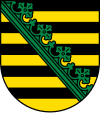Saxon State Ministry for Science, Culture and Tourism
|
Saxon State Ministry for Science, Culture and Tourism |
|
|---|---|

|
|
| State level | country |
| position | Supreme state authority |
| founding | 1990 |
| Headquarters | Dresden |
| Authority management |
Sebastian Gemkow ( CDU ), Minister of State for Science Barbara Klepsch ( CDU ), Minister of State for Culture and Tourism |
| Budget volume | 2.110 billion euros (2019) |
| Web presence | www.smwk.sachsen.de |
The State Ministry for Science, Culture and Tourism (SMWK) is a supreme state authority of the Free State of Saxony with its seat in the state capital Dresden . It has been the supervisory authority for higher education since the Free State was founded in 1990 and was called the State Ministry for Science and Art until 2019 . The ministry is located in the government district at Wigardstrasse 17 on the site of the former Dreikönigschule . Predecessor authorities did not exist in "old" Saxony; the Ministry of Education was responsible for these tasks . Sebastian Gemkow ( CDU ) as Minister of State for Science and Barbara Klepsch (CDU) as Minister of State for Culture and Tourism have headed the authority since 2019 . State Secretary for Science is Andrea Franke (CDU).
tasks

The Saxon State Ministry for Science and Art is responsible for higher education in Saxony , in particular for universities and university clinics . The ministry is also responsible for art colleges and universities of technology and business ( technical colleges ) as well as vocational academies. The ministry regulates matters relating to university admission and teaching capacities and defines the study and examination regulations. It coordinates distance learning as well as scientific training.
The ministry is still responsible for student affairs, for example student unions . At the international level, the Saxon State Ministry for Science and Art is responsible for supraregional issues of research, education and cultural policy as well as for the recognition and evaluation of foreign and domestic university degrees.
Other tasks of the ministry consist in the promotion of training at schools and universities, in the facilitation of institutionally funded facilities outside the university area, in the promotion of research and young scientists in Saxony and the transfer of science.
In the cultural field, it operates and supports public and academic libraries . Another task is the maintenance and promotion of art and culture, especially in state theaters, orchestras and museums. It is intended to promote artists, literature and film and is superordinate to the specialist authorities for monument preservation and archeology in Saxony.
structure
The Ministry consists of the offices of the Minister of State and the Secretary of State, the Management Office and the Press Office, as well as the Theater and Orchestra Commissioners. Thereafter there are four departments , each of which has departments assigned (e.g. department 11 to department 1).
| Department 1 Central Affairs |
Department 2 art |
Department 3 Universities |
Department 4 Research |
Department 5 Tourism |
|---|---|---|---|---|
|
|
|
|
|
Subordinate business area
The following institutions of the Saxon State Ministry for Science and Art are part of the subordinate division:
- State Office for Archeology of Saxony
- Saxon State Library - Dresden State and University Library
- State Art Collections Dresden
- Saxon State Theater
Minister of State
- 1990–2002: Hans Joachim Meyer ( CDU )
- 2002–2004: Matthias Rößler (CDU)
- 2004–2006: Barbara Ludwig (SPD)
- 2006–2009: Eva-Maria Stange (SPD)
- 2009–2014: Sabine von Schorlemer (independent, proposal from CDU)
- 2014–2019: Eva-Maria Stange (SPD)
History of universities in Saxony
The University of Leipzig , founded in 1409, is the second oldest German university after the Ruprecht-Karls-Universität Heidelberg , which came into being after the Germans moved out of the Charles University in Prague . Martin Luther initiated the Reformation from the University of Wittenberg, which was founded in Ernestine Saxony (no longer ruled from Dresden since 1815) . The oldest forerunner of the Leipzig University of Technology, Economics and Culture goes back to 1764 . The Bergakademie Freiberg was founded in 1765 to further promote the mining sciences . In the 19th century the engineering sciences developed strongly due to industrialization . The Technische Bildungsanstalt in Dresden, today the Technical University of Dresden , was established in 1828. The forerunners of the Technical University of Chemnitz (1836), the University of Zwickau (1828/1897) and the University of Zittau / Görlitz (1836) came into being a little later.
Saxon Art Prize for Tolerance and Democracy
The State Ministry awarded the Saxon Art Prize for Tolerance and Democracy in cooperation with the State Association of Soziokultur Sachsen eV . This award honors artists or organizations who have made a special contribution to sociocultural projects. The prize is endowed with 3,000 euros and was last awarded in 2011.
- Award winners
- 2009: District forum IDEE 01239 e. V. in Dresden-Prohlis
- 2011: Art project Words to Lean on by Rupprecht Matthies and the KunstRaum Dresden at the Language Support Center in Dresden
Web links
Individual evidence
- ↑ Record budget for science and art: for the first time more than two billion euros per year. Saxon State Ministry for Science and Art, December 12, 2018, accessed on October 23, 2019 (press release).
- ^ Prime Minister Kretschmer introduces new government. sachsen.de, December 20, 2019, accessed on December 20, 2019 .
- ↑ Organization chart. (PDF; 252 kB ) In: smwk.sachsen.de. Saxon State Ministry for Science and Art, July 1, 2020, accessed on July 14, 2020 .
- ^ Saxon Art Prize for Tolerance and Democracy , Landesverband Soziokultur Sachsen eV
- ^ Landesverband Soziokultur Sachsen - Saxon Art Prize for Democracy and Tolerance 2011